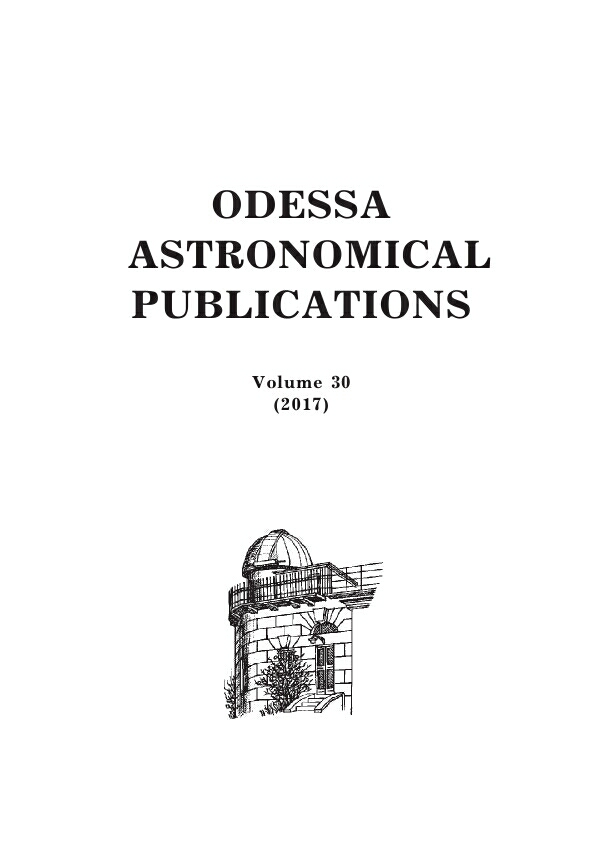PHYSICAL PARAMETERS OF PROTOPLANETARY DISK SURROUNDING IRAS 22150+6109 YOUNG STAR
DOI:
https://doi.org/10.18524/1810-4215.2017.30.114371Ключові слова:
IRAS 22150 6109, protoplanetary diskАнотація
IRAS 22150+6109 star belongs to L 1188 star forming region in Perseus, according to [1] located at distance of 910 pc from the Sun. Photometric observations in the visible range that were carried out in 1997-1999 have revealed the following features of the object: source variability 0.2m, interstellar absorption reaches the value of AV = 2m [2], visual brightness of V ≈ 10.8m [3]. In near IR region (JHK bands) the emission excess is observed around 1m in comparison with visible range: J ≈ 9.8m, H ≈ 9.7m, K ≈ 9.6m [4]. Flux data in four bands contained in WISE catalog [5], confirmed the further increase of IR-excess in wavelength range of 3.4-21 µm. According to AKARI catalog [6] where the emission fluxes are in wavelength range of 18-160 µm, IR-flux increase continues nearly about 60 µm, thereafter it starts to decrease. Such star’s spectral energy distribution (SED) is typical in the presence of dust disk surrounding it. According to the analysis of color average data in optical range and optical spectrum, star’s spectral classcan be determined as В2-В3 of initial main sequence [7]. Fundamental parameters assessment according to [8] is as follows: weight – 6.5 0.5 Мsun and radius – 5 Rsun. The aim of the work is to carry out the analysis of star’s coherent astrophysical parameters and on their basis todetermine parameters of the disk surrounding it.
Посилання
Abruham P., Dobashi K., Mizuno A. et al.: 1995, Astron. Astrophys., 300, 525.
Kuratov K.S.: 2004, Transact., Nat., Academ., Kazakhst., 4.
Hog E., Fabricius C., Makarov V.V. et al.: 2000, Astron. Astrophys., 355, L27. Cutri R.M. et al.: 2003, ADC Collection of Electronic Catalogues, 2246.
Wright E.L., Eisenhardt P.R.M., Mainzer A.K. et al.: 2010, Astron. Astrophys., 140, 1868.
Murakami H., Baba H., Barthel B. et al.: 2007, PASJ, 59, 369.
Zakhozhay O.V., Miroshnichenko A.S., Kuratov K.S., et al.: 2017, Proc. of the conf. The B[e] Phenomenon: Forty Years of Studies. ASP Conf. Ser., 508, 191.
Palla P., Stahler S.V.: 1993, Astrophys. J., 418, 414.
Pecaut M.J., Mamajek E.C.: 2013, Astrophys. J. Suppl. Ser., 208, 9.
Pecaut M.J., Mamajek E.C., Bubar E.: 2012, Astrophys. J., 746, 154.
Straizhys V., Kuriliene G.: 1981, Astrophys. Sp. Sci., 80, No. 2, 353.
Zakhozhay O., Zapatero Osorio M.R., Bejar V., Boehler Y.: 2017, MNRAS, 464, 1108.
Zakhozhay O.V.: 2017, Kinem. and Phys. of Cel. Bod., 33, is. 4, in press.
Dullemond C. P., Dominik C., Natta A.: 2001, ApJ, 560, 957.
Zakhozhay V.A., Zakhozhay O.V., Vidmachenko A.P.: 2011, Kinem. and Phys. of Cel. Bod., 27, 140.
Zakhozhay O.V., del Burgo C., Zakhozhay V.A.: 2015, Adv. in Astron. and Space Phys., 5, 33.
Surdin V.G.: 2001, Birth of stars. М: URSS, 264 p.
##submission.downloads##
Опубліковано
Номер
Розділ
Ліцензія
Авторське право (c) 2017 Odessa Astronomical Publications

Ця робота ліцензується відповідно до Creative Commons Attribution-NonCommercial 4.0 International License.
Відповідно Закону України про авторське право і суміжні права N 3792-XII від 23 грудня 1993 року
